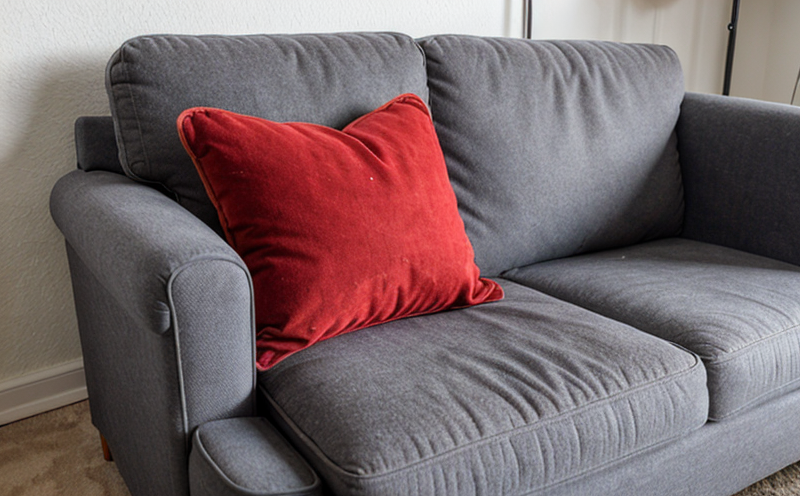ISO 13936 Determination of Seam Slippage Resistance in Upholstered Cushions
The ISO 13936 test method is a critical standard used to determine the seam slippage resistance of cushions within upholstered furniture. This durability testing ensures that seams do not slip or fail under typical use conditions, which can lead to discomfort and instability for end users. Seam failure compromises both product integrity and user safety, making this test essential for quality assurance in the furniture industry.
The primary focus of ISO 13936 is on the mechanical strength of seams in cushion fabrics. This method evaluates how well a seam holds up against forces that could cause it to slip or fail during normal use. The test simulates real-world conditions, providing an accurate assessment of the durability and longevity of furniture products.
The testing procedure involves clamping one end of the cushion fabric sample between two grips and subjecting the other end to a specified force in a specific direction. This force is applied until seam slippage occurs or the test reaches its predetermined limit. The results are then recorded, allowing manufacturers to compare different materials and designs effectively.
The importance of this test cannot be overstated, especially given the high standards demanded by modern consumers and regulatory bodies. Furniture that meets ISO 13936 ensures consistent quality across all products, reducing customer complaints and recalls while enhancing brand reputation.
Moreover, compliance with this standard helps manufacturers meet industry benchmarks and international regulations, ensuring that their products are safe and reliable for global markets. For furniture companies focused on sustainability and longevity, this test is particularly valuable in evaluating how well materials withstand the rigors of daily use without compromising safety or comfort.
The procedure described by ISO 13936 ensures that seam slippage resistance is accurately measured, providing a solid foundation for quality control initiatives. By incorporating this test into their product development and manufacturing processes, furniture companies can ensure they are delivering products that meet the highest standards of durability and safety.
Understanding the practical aspects of ISO 13936 helps stakeholders appreciate its significance in the broader context of upholstery and cushion design. This method is not just about checking seams; it’s about ensuring that every aspect of a cushion contributes to overall product integrity and user satisfaction.
- Precision Measurement: The test ensures precise measurement of seam slippage, providing reliable data for quality control.
- Consistency: By standardizing the testing process, ISO 13936 helps maintain consistent product performance across different batches and manufacturers.
- User Safety: Ensuring seams do not slip reduces the risk of accidents and enhances user safety.
In conclusion, the ISO 13936 test is a cornerstone in maintaining high standards within the upholstery and cushion industry. It ensures that products are durable, safe, and reliable, aligning with both consumer expectations and regulatory requirements.
Why Choose This Test
The ISO 13936 test stands out for its precision and reliability in evaluating seam slippage resistance, making it an indispensable tool for quality assurance in the upholstery industry. Its standardized approach ensures consistent results across different materials and manufacturers, providing a solid foundation for product development and improvement.
- Standardized Results: The test yields reproducible outcomes, facilitating comparison between samples and manufacturing batches.
- Rigorous Assessment: ISO 13936 provides a thorough evaluation of seam durability, identifying potential weaknesses early in the production process.
- Regulatory Compliance: Adhering to this standard ensures that products meet international quality benchmarks and regulatory requirements.
The test’s precision and reliability are crucial for maintaining high standards within the industry. By ensuring consistent seam slippage resistance, manufacturers can enhance product durability and safety, ultimately leading to greater customer satisfaction and brand reputation.
Quality and Reliability Assurance
The ISO 13936 test plays a vital role in quality control by providing accurate data on seam slippage resistance. This ensures that products meet rigorous durability standards, which is crucial for maintaining customer trust and satisfaction. By incorporating this test into their manufacturing processes, furniture companies can identify and address potential issues early in the production cycle.
Compliance with ISO 13936 also helps manufacturers stay ahead of regulatory changes and industry trends. As consumer expectations continue to rise, adhering to this standard ensures that products are not only durable but also meet the highest standards of safety and comfort. This can lead to increased market share and a stronger brand reputation.
The test’s reliability is further enhanced by its consistency across different manufacturers and materials. By using standardized testing methods, companies can ensure that their products consistently meet or exceed quality benchmarks. This consistency is particularly important in the global market, where regulatory standards vary by region.
In conclusion, ISO 13936 is an essential tool for ensuring product reliability and durability. Its precision and repeatability make it a valuable asset for any furniture manufacturer committed to delivering high-quality products that meet both domestic and international standards.
Customer Impact and Satisfaction
The ISO 13936 test directly impacts customer satisfaction by ensuring product durability and safety. By reducing the risk of seam slippage, manufacturers can deliver furniture that is comfortable and stable, enhancing user experience. This contributes to higher levels of customer satisfaction, which in turn drives repeat business and positive brand loyalty.
Moreover, compliance with this standard helps companies meet regulatory requirements, ensuring they are selling products that are safe for consumers. This builds trust between the manufacturer and their customers, fostering long-term relationships. For businesses focused on sustainability and longevity, ISO 13936 is particularly valuable in evaluating how well materials withstand daily use without compromising safety or comfort.
The test’s precision ensures consistent product performance across different batches and manufacturers, which is crucial for maintaining high standards of quality control. This consistency enhances customer confidence, knowing that they are receiving products that meet the highest industry benchmarks.
In conclusion, ISO 13936 plays a significant role in enhancing customer satisfaction by ensuring durable and safe furniture products. Its impact on product reliability and safety contributes to greater customer trust and loyalty, ultimately driving business success.





